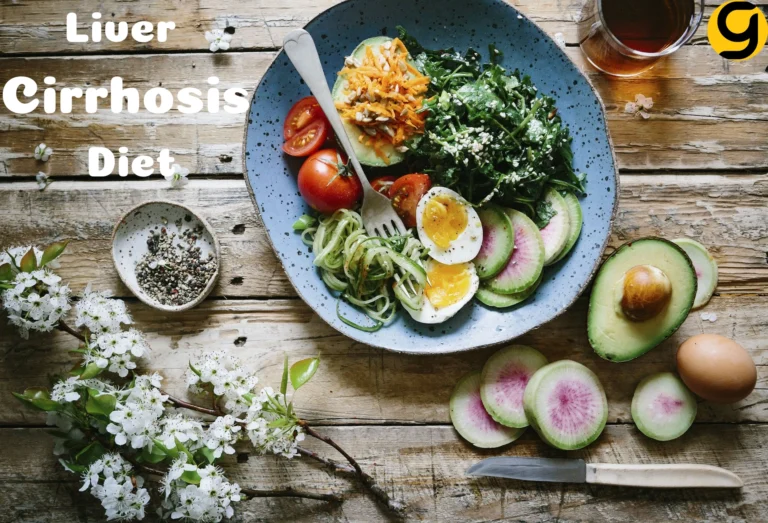The dangerous illness known as liver cirrhosis is characterized by the scarring of the liver tissue, which compromises liver function. Adopting a liver-friendly diet is essential for maintaining overall liver function and controlling symptoms, even though medicinal care is still requiring. We will go over the fundamentals of a liver cirrhosis diet, important dietary concerns, and frequently asked questions in this comprehensive guide to help people manage this difficult illness.
Comprehending Liver Cirrhosis
Liver Cirrhosis: What is it?
Long-term liver injury and inflammation cause liver cirrhosis, which is characterised by the replacement of good liver tissue by scar tissue. The liver’s capacity to perform its vital functions, including detoxification, metabolism, and nutrition storage, is compromised by this scarring.
Common Causes of Liver Cirrhosis :
- Persistent alcoholism
- Hepatitis virus (B, C)
- illness of the non-alcoholic fatty liver (NAFLD)
- Inflammatory hepatitis
- Hemochromatosis, or excess iron
- Wilson’s illness caused by copper buildup
Symptoms of Liver Cirrhosis :
- Weakness and Fatigue
- stomach ache and edoema
- Simple bleeding and bruises
- Jaundice, or the yellowing of the eyes and skin
- Bewilderment and mental health problems
- Diet’s Impact on Liver Cirrhosis
Main Dietary Goals:
Reduce Liver Stress: Eat meals that are high in nutrients and readily digested to lessen the strain on the liver.
Control Fluid Retention: Reduce your consumption of salt to prevent the body from accumulating fluid, which is a major problem with cirrhosis.
Prevent Malnutrition: People with cirrhosis are frequently concerned about malnutrition, so make sure they are getting enough nutrition to avoid it.
Managing Protein Intake: Maintaining muscle mass without overtaxing the liver requires a balanced intake of protein.
Read Also –LGBTQ Health- 6 Best Electric Toothbrush For Strong Teeth
Health Tip
Maintain a balanced protein intake to help maintain muscle mass without overtaxing the liver. The amount of protein that each person requires varies, so speak with a healthcare provider.
Dietary Guidelines for Liver Cirrhosis
1. Limiting Sodium:
Fresh produce, whole grains, and low-sodium substitutes are a few examples.
Steer clear of processed meals, pickles, canned soups, and high-sodium snacks.
2. Consumption of Protein:
Lean protein sources such fish, chicken, tofu, and beans should include.
Limit: To lessen the strain on the liver, limit red and processed meats.
3. Adaptable Administration:
Keep an eye on your fluid intake, particularly if you have fluid retention. Seek advice from a medical expert for customised fluid recommendations.
4. Foods High in Nutrients:
Add: Nuts, seeds, whole grains, and colourful fruits and vegetables to supply vital vitamins and minerals.
5. Good Fats:
Include Avocados, salmon, and other fatty seafood, as well as unsaturated fats from olive oil.
Limit: Fried meals and processed snacks that contain trans and saturated fats.
Read Also – Fitbit- List Of Best Fitbit For LGBTQ And All
6. Light Dinners Often:
The liver’s job of digestion can lessen by eating smaller, more frequent meals.
7. Restrict Alcohol Use:
Avoid drinking alcohol since it might make liver disease worse.
8. Supplements with vitamins and minerals:
Consult a medical expert to ascertain whether supplements are require remedying any possible deficiencies.
In Conclusion
A well-managed diet for liver cirrhosis is essential to maintaining liver function and enhancing general health. People with cirrhosis can improve their quality of life, optimise nutrition, and also control their symptoms by adhering to dietary guidelines. It’s important to approach dietary modifications under the supervision of medical specialists to make sure the diet plan is customize to each patient’s needs and in line with overall treatment objectives. Through a proactive and knowledgeable diet, people may take charge of their journey towards better vitality and liver health as well as.
Key takeaways
- Exercise Regularly: Engaging in regular physical activity can help maintain a healthy weight, improve circulation, and support overall liver health in transgender individuals with cirrhosis.
- Consult Healthcare Providers: Transgender individuals with cirrhosis should work closely with healthcare providers, including dietitians and hepatologists, to develop a personalized diet plan and monitor liver function regularly.
- Healthy Fats: Including healthy fats, such as those found in avocados, nuts, seeds, and fatty fish, can provide essential nutrients and support liver health in transgender individuals with cirrhosis.
- Supportive Community: Seeking support from healthcare providers, support groups, and online communities can provide valuable guidance, encouragement, and emotional support for transgender individuals navigating a liver cirrhosis diet.
Frequently Asked Questions
Q: Why is it important for transgender individuals to follow a specific liver cirrhosis diet?
A: Transgender individuals may have unique health considerations, and certain hormone therapies or medical treatments can impact liver health, making it crucial to follow a specialized diet to manage cirrhosis effectively.
Q: What are the key dietary goals for transgender individuals with liver cirrhosis?
A: The primary goals of a liver cirrhosis diet for transgender individuals are to support liver function, manage symptoms, prevent complications, and optimize overall health and well-being.
Q: What foods should transgender individuals with liver cirrhosis include in their diet?
A: A balanced diet rich in fruits, vegetables, whole grains, lean proteins, and healthy fats is recommended. Foods high in fiber, vitamins, and antioxidants can support liver health and overall wellness.
Q: Are there specific foods that transgender individuals with liver cirrhosis should avoid?
A: Transgender individuals with liver cirrhosis should limit or avoid alcohol, high-sodium foods, processed foods, saturated fats, and foods high in added sugars, as these can exacerbate liver damage and complications.



